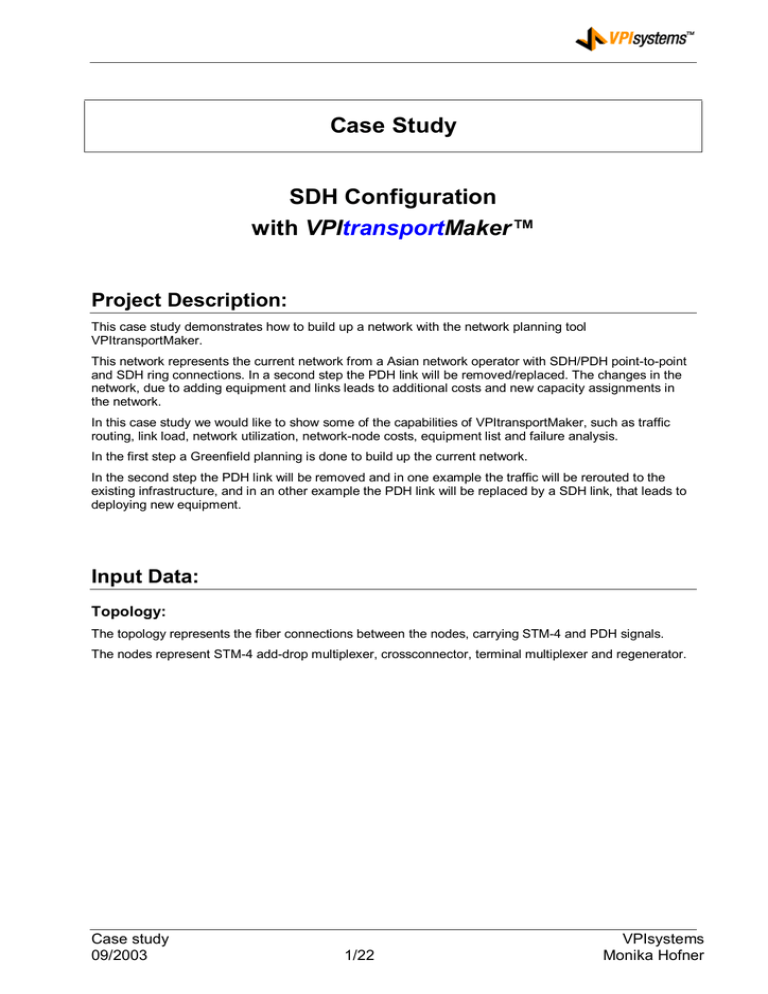Case Study SDH Configuration VPI Maker™
advertisement

Case Study SDH Configuration with VPItransportMaker™ Project Description: This case study demonstrates how to build up a network with the network planning tool VPItransportMaker. This network represents the current network from a Asian network operator with SDH/PDH point-to-point and SDH ring connections. In a second step the PDH link will be removed/replaced. The changes in the network, due to adding equipment and links leads to additional costs and new capacity assignments in the network. In this case study we would like to show some of the capabilities of VPItransportMaker, such as traffic routing, link load, network utilization, network-node costs, equipment list and failure analysis. In the first step a Greenfield planning is done to build up the current network. In the second step the PDH link will be removed and in one example the traffic will be rerouted to the existing infrastructure, and in an other example the PDH link will be replaced by a SDH link, that leads to deploying new equipment. Input Data: Topology: The topology represents the fiber connections between the nodes, carrying STM-4 and PDH signals. The nodes represent STM-4 add-drop multiplexer, crossconnector, terminal multiplexer and regenerator. Case study 09/2003 1/22 VPIsystems Monika Hofner Figure – Network Topology shown in the GUI (Graphical User Interface) The following figure shows the attributes for one fiber link: Figure – Fiber link attributes Case study 09/2003 2/22 VPIsystems Monika Hofner Traffic: We assume some traffic demands, because we have no information about the traffic. In this case study two traffic matrices are defined – E1 and VC4 traffic demands: Figure – 2 MB (E1) traffic matrix (fully meshed) Case study 09/2003 Figure – VC4 traffic matrix 3/22 VPIsystems Monika Hofner Network Design – Greenfield Planning: For the network design -meeting the customer requirements- the following design steps are done: All the traffic demands must be multiplexed into higher layer: ! 2 MB demands are multiplexed first to VC-4 and than to STM-4 ! VC-4 traffic demands are multiplexed to STM-4 ! some 2 MB demands are multiplexed to E4 (140 MB), routed onto the PDK link The architecture covers different requests, such as: ! point-to-point connection carrying the PDH signal, ! point-to-point connection carrying SDH signals which are protected by 1+1 MSP protection ! BSHR 2-fiber ring protection carrying STM-4 signals 1+1 MSP Protection 4-fiber BSHR Ring Protection 2-fiber Point-to-point PDH connection Figure – Hybrid Architecture Case study 09/2003 4/22 VPIsystems Monika Hofner In the first design step the traffic must be split into sub-networks to achieve a hybrid architecture: Figures – The traffic matrices 2 MB (left) and VC4 (right) are split at the crossconnector PL2:SDXC-4 into 2 subnetworks. E.g. the traffic demand from MM3:TM-4 to TL3:ADM is split into two sections: - from MM3:TM-4 to PL2:SDXC-4. This traffic section will be designed with 1+1 protection in the next planning step - from PL2:SDXC-4 to TL3:ADM. This traffic section will be designed with BSHR ring protection in the next planning step The next steps shows the design of each architecture separately: Case study 09/2003 5/22 VPIsystems Monika Hofner Design step: 1+1 MSP Protection 4-fiber The both traffic matrices are routed on the upper fiber section with the following routing options: Figure – Routing options Figure – Routing of the VC4 traffic on the fiber without protection. The path is selected and highlighted in the GUI. The label shows the traffic load (TL). Case study 09/2003 6/22 VPIsystems Monika Hofner Both traffic matrices are multiplexed into the higher layer STM-4: Figure – Bundling/multiplex options with the selected target layer STM-4 To consider the requested 1+1 Protection, the new created STM-4 traffic must be routed on the fiber with the routing option 1+1: Figure – Routing options Case study 09/2003 7/22 VPIsystems Monika Hofner Figure – Result : Number of STM-4 signals routed on the fiber (TL represents Traffic Load) with 1+1 protection. Here 3 x STM-4 are on each fiber pair. The working path is selected and highlighted in the GUI. Case study 09/2003 8/22 VPIsystems Monika Hofner Design step: BSHR Ring Protection 2-fiber The application ‘Automatic Ring Designer’ in VPItransportMaker is a cost driven algorithm creating optimized rings, by taking costs into account, such as equipment and fiber costs. Besides the costs the optimization algorithm takes constraints into account, like the technical constraints of the equipment, existing rings and capacity constraints on the fiber. The ring protection and the add-drop multiplexer with the corresponding specification and costs are defined within an equipment library: Figure – Definition of ring technologies After running the ‘Automatic Ring Designer’ (manual design is also possible) the result is the following: The 2 MB and VC4 traffic are routed on the fiber and multiplexed to STM-4 layer, by guaranteeing the 2-fiber BSHR/MSSPRING protection. Case study 09/2003 9/22 VPIsystems Monika Hofner In total 9 x STM-4 rings with 2-fiber BSHR protection are generated: Figure – List of the generated STM-4 rings with length, load and costs In the upper figure the STM-4 ring ‘ModRing5’ is highlighted and automatically displayed in the GUI (Graphical User Interface): Figure - Visualizing one of the 8 x STM-4 BSHR rings in the GUI (Graphical User Interface): The red line represent the physical ring, carrying the STM-4 signal. The highlighted nodes represent the necessary ADM function for this specific ring. The un-highlighted nodes show, that these nodes need no ADM functionality. That means the traffic can be through-connected in these nodes, which saves CapEx. Case study 09/2003 10/22 VPIsystems Monika Hofner Figure - Second fiber ring carrying 1 x STM-4 BSHR. In total 8 x ‘big’ STM-4 BSHR rings are created and 1 x ‘smaller’ STM-4 BSHR. The next figure shows the total load of the STM-4 rings on the fiber: Figure - Visualizing the traffic load (TL). Case study 09/2003 11/22 VPIsystems Monika Hofner Besides showing the results in the GUI, the results can be documented in a MS EXCEL report, generated in VPItransportMaker: Figure – Report with the tab ‘Ring Design Summary’, showing the number of generated rings, the necessary equipment and the costs. Case study 09/2003 12/22 VPIsystems Monika Hofner For detailed information many tabs are available to break down the information. Some excerpts are shown in the next figures: Figure – Ring Report, tab ‘Ring Details’ showing the rings with the corresponding fiber sections and the utilization of each fiber span. The documentation of the ring/link utilization helps in doing a later extension planning. The provisioning of new capacity can be done much more faster, due to exacter predictability. Case study 09/2003 13/22 VPIsystems Monika Hofner Figure – Ring Report, tab ‘Node Summary’ showing the number of ADM and regenerator (for through connecting STM-4 rings) for each node, and a detailed list about the necessary tributary ports for adding/dropping the E1 and VC4 traffic and the necessary ports for interring traffic (traffic can go through more than one ring to improve the utilization). Case study 09/2003 14/22 VPIsystems Monika Hofner Design step: Point-to-point PDH traffic On the fiber section between WN R/R:ADM-4 and SNO R/R:ADM-4 there is an existing PDH system. In this cases study the 2 MB signals are routed on this link and multiplexed to E4. Figure – The PDH signal E4 carries 80 x E1 traffic. The right window shows the fiber and E4 layer. Case study 09/2003 15/22 VPIsystems Monika Hofner The total network design with the hybrid architecture can be shown now: 2 x 3 STM-4 (1+1 MSP Protection 4-fiber) 9 x STM-4 BSHR rings 2-fiber on 2 x fiber rings 1 x E4 Point-to-point PDH traffic Figure – The total network with the number of SDH/PDH signals. Case study 09/2003 16/22 VPIsystems Monika Hofner What-if Scenario: With VPItransportMaker different failure scenarios can be simulated, such as link- and node failures. The next example simulates a node failure in node WN R/R:ADM-4 fails. The lost traffic is evaluated: Figure – Excerpt of the Node Failure Report, showing the lost traffic (here for all layer) in a summary and the effected traffic pathes. Case study 09/2003 17/22 VPIsystems Monika Hofner Network Design – Removing/Replacing PDH link: In the second design step, the existing PDH link will be removed. The traffic, routed on the PDH link must be deleted, first. To reroute the traffic, there are two possibilities: 1. The traffic is supposed to be routed on the existing rings only. 2. The PDH link is replaced by a SDH link and a new STM-4 ring must be created. 1. The traffic is rerouted on the existing rings With the following option of the VPItransportMaker application ‘Automatic Ring Designer’ the user can restrict the rerouting of traffic on existing rings only: Figure – Command in the menu to do the routing on existing rings only This means in this case study, that there is no SDH link replacing the PDH link. Additional options can be selected to define constraints, such as maximum number of rings. VPItransportMaker is analyzing the total network, if there is enough capacity for the additional traffic. This can lead to big detours (crossing many rings or routing the traffic via long distances). To avoid delay, the user can define these constraints: Figure – Definition of additional constraints Case study 09/2003 18/22 VPIsystems Monika Hofner When the algorithm is finished, a report is generated. If there is not enough capacity in the network to carry the additional traffic, than the amount of unroutable traffic is displayed in the report, tab ‘Unrouted Demands’. In this example all the traffic could be routed: Figures – Routing information of the traffic in the report The figure above shows, that all the traffic was routed on one ring only (ModRing9). Case study 09/2003 19/22 VPIsystems Monika Hofner The utilization of the network is higher with this additional traffic: Figure – Utilization of the Ring9 before routing the additional traffic Figure – Utilization of the Ring9 with the rerouted traffic Case study 09/2003 20/22 VPIsystems Monika Hofner 2. Routing the traffic on a new infrastructure by creating a new STM-4 ring The PDH link should be replaced by a SDH link. Therefore a new STM-4 ring must be created. This can be done automatically by VPItransportMaker: Figure – A new STM-4 BSHR 2-fiber ring is created routed on the fiber (right window) A delta report is generated automatically, giving the information for the new ring, the corresponding costs, utilization, new equipment and the routing information: Figure – Delta report, tab ‘Ring Design Summary’ for the new created STM-4 ring Case study 09/2003 21/22 VPIsystems Monika Hofner Figure – Amount of new equipment (ADM) and equipment costs for the network extension Summary: This case study shows how to create a new network, how to build up a customer network, how to do extension planning and how to replace existing infrastructure. With VPItransportMaker the planning process can be improved, by using very high sophisticated algorithms to get faster results, cost optimized network design and improved predictability. With VPItransportMaker the operator can save CapEx in terms of time reduction of the lifecycle process and higher utilization of the network (fiber capacities and equipment deployment and usage) and save OpEx in terms of less equipment to be maintained. Case study 09/2003 22/22 VPIsystems Monika Hofner





